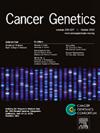HSP110 T17标记物在散发性结直肠癌微卫星不稳定性检测中的表现优于CAT-25
IF 2.1
4区 医学
Q4 GENETICS & HEREDITY
引用次数: 0
摘要
微卫星不稳定性(Microsatellite instability, MSI)是结直肠癌(CRC)的重要生物标志物,影响预后和治疗决策。虽然传统的MSI检测通常依赖于五轴体面板,但HSP110 T17 (HT-17)和CAT-25等较新的标记物可能提供更简单、更经济的替代方案。本研究旨在评估HT-17和CAT-25在散发性结直肠癌中检测MSI的有效性,并探讨MSI状态与临床病理特征之间的联系。共纳入96例突尼斯散发性结直肠癌患者,通过微卫星基因分型,使用HT-17、CAT-25和精细单核苷酸重复五联体小组评估MSI状态。临床病理数据,如肿瘤位置和诊断时的年龄,也被分析与MSI的关系。96例患者中,9例(9.38%)为MSI, 87例为微卫星稳定(MSS)。HT-17具有100%的准确度和灵敏度,与五轴面板的性能相匹配,而CAT-25的检测能力有限。MSI状态与近端结肠肿瘤显著相关,出乎意料的是,年轻患者(50岁)也存在MSI状态。HT-17被证明是CRC中可靠的MSI标记物,提供与五轴面板相当的性能,具有简单和成本效益的额外优势。MSI、肿瘤位置和诊断年龄之间的关系可能为CRC生物学和临床管理提供有价值的见解。为了提高CRC患者的个性化治疗策略和预后准确性,还需要更大规模的进一步研究来验证HT-17的临床潜力。本文章由计算机程序翻译,如有差异,请以英文原文为准。
HSP110 T17 marker matches the pentaplex panel and outperforms CAT-25 for detecting microsatellite instability in sporadic colorectal cancer
Microsatellite instability (MSI) is an important biomarker in colorectal cancer (CRC), influencing prognosis and treatment decisions. While conventional MSI detection typically relies on the pentaplex panel, newer markers like HSP110 T17 (HT-17) and CAT-25 may offer simpler, more cost-effective alternatives. This study aimed to assess the effectiveness of HT-17 and CAT-25 for detecting MSI in sporadic CRC and to explore any links between MSI status and clinicopathological features. A total of 96 Tunisian sporadic CRC patients were included, with MSI status evaluated using HT-17, CAT-25, and the refined mononucleotide repeat pentaplex panel through microsatellite genotyping. Clinicopathological data, such as tumor location and age at diagnosis, were also analyzed for associations with MSI. Among the 96 patients, 9 (9.38%) showed MSI, while 87 were microsatellite stable (MSS). HT-17 demonstrated 100% accuracy and sensitivity, matching the pentaplex panel's performance, while CAT-25 showed limited detection ability. MSI status was significantly linked to tumors in the proximal colon and, unexpectedly, to younger patients (<50 years old). HT-17 proved to be a reliable MSI marker in CRC, offering equivalent performance to the pentaplex panel, with the added advantages of simplicity and cost efficiency. The associations between MSI, tumor location, and younger age at diagnosis may provide valuable insights into CRC biology and clinical management. Further studies with larger cohorts are needed to validate HT-17′ s clinical potential, with the goal of improving personalized treatment strategies and prognostic accuracy for CRC patients.
求助全文
通过发布文献求助,成功后即可免费获取论文全文。
去求助
来源期刊

Cancer Genetics
ONCOLOGY-GENETICS & HEREDITY
CiteScore
3.20
自引率
5.30%
发文量
167
审稿时长
27 days
期刊介绍:
The aim of Cancer Genetics is to publish high quality scientific papers on the cellular, genetic and molecular aspects of cancer, including cancer predisposition and clinical diagnostic applications. Specific areas of interest include descriptions of new chromosomal, molecular or epigenetic alterations in benign and malignant diseases; novel laboratory approaches for identification and characterization of chromosomal rearrangements or genomic alterations in cancer cells; correlation of genetic changes with pathology and clinical presentation; and the molecular genetics of cancer predisposition. To reach a basic science and clinical multidisciplinary audience, we welcome original full-length articles, reviews, meeting summaries, brief reports, and letters to the editor.
 求助内容:
求助内容: 应助结果提醒方式:
应助结果提醒方式:


